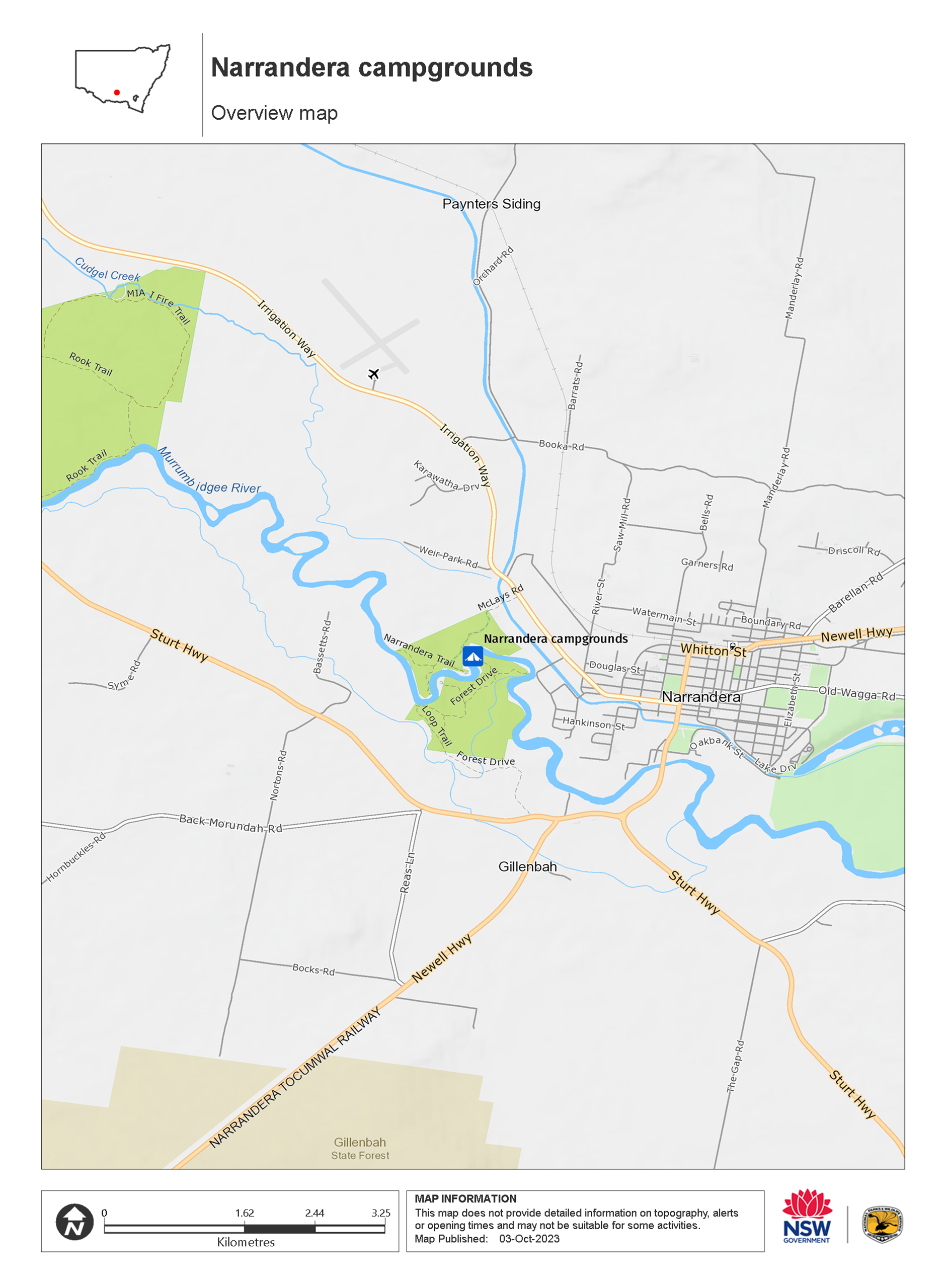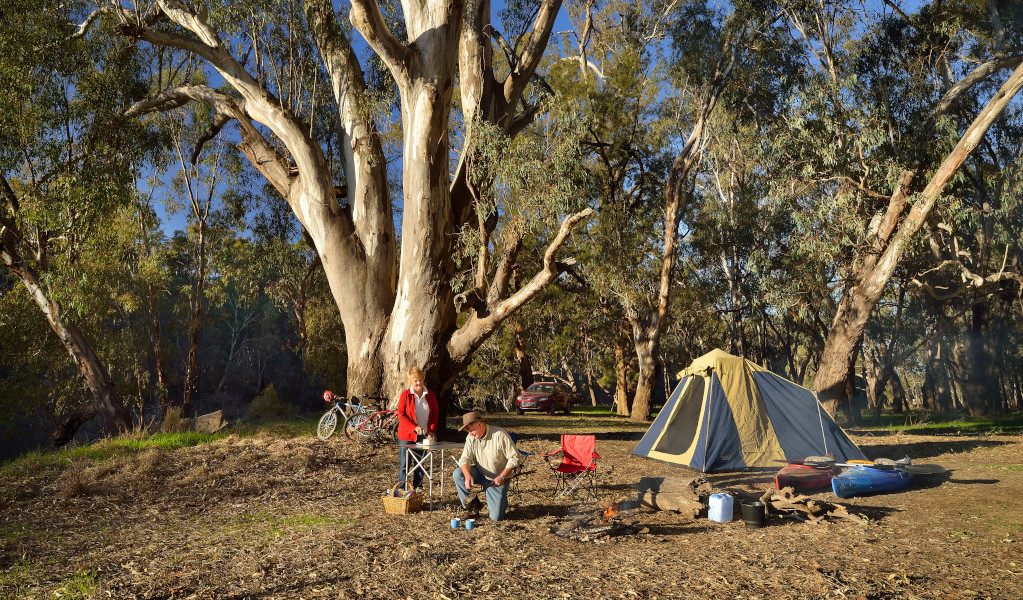Narrandera campgrounds
Murrumbidgee Valley Regional Park
Overview
Camp with your dog at one of the 7 campgrounds in the Narrandera area of Murrumbidgee Valley Regional Park.
You can choose to camp at any of these 7 locations when you arrive:
- High Bank
- Koalas Hut
- Old Sand Mine Beach
- Jacko’s Beach
- Munyaa Beach
- Narrandera Beach
- South Bank
There are no camping fees but a $6 booking fee applies. Bookings are required.
Permitted
- Campfires are permitted between April and September.
- Collection of deadfall timber is permitted for small campfires only.
- Dogs and domestic pets are permitted everywhere in Murrumbidgee Valley Regional Park, but they are prohibited in Murrumbidgee Valley National Park. You can walk and camp with your dog in Murrumbidgee Valley Regional Park but you will need to keep them on a leash at all times and remember to pick up after them.
Prohibited
You can't remove firewood from the park. Chainsaws are not permitted.
Vehicle access and road quality
All roads leading to Narrandera campgrounds are unsealed. 4WD vehicles are recommended when wet. Campervans/RVs are permitted in this area, however not all campgrounds suit these types of vehicles.
How to get there
From Narrandera to Narrandera North precinct:
- Travel 2.5km northwest along Irrigation Way.
- Turn left onto an unsealed road and travel for about 450m.
- This is the main entrance to Narrandera North.
From Narrandera to Narrandera South precinct:
- Travel 4km southeast along the Newell Highway.
- Turn right onto Forest Drive which is an unsealed road and travel for about 1km.
- This is the main entrance to Narrandera South.
There are no rubbish collection points. Please take all rubbish when you leave.
These maps give a basic overview of park attractions and facilities, and may not be detailed enough for some activities. We recommend that you buy a topographic map before you go exploring.
Map

Map legend

Local alerts
For the latest updates on fires, closures and other alerts in this area, see https://www.nationalparks.nsw.gov.au/camping-and-accommodation/campgrounds/narrandera-campgrounds/local-alerts
Bookings
- National Parks Contact Centre
- 7am to 7pm daily
- 1300 072 757 (13000 PARKS) for the cost of a local call within Australia excluding mobiles
- parks.info@environment.nsw.gov.au
Operated by
- Griffith office
- Monday to Friday, 9am to 4pm. Closed 1pm to 2pm.
- 02 6966 8100
- npws.riverina@environment.nsw.gov.au
- 200 Yambil Street, Griffith NSW 2680
Park info
- in Murrumbidgee Valley Regional Park in the Murray-Riverina region
Murrumbidgee Valley Regional Park is always open but may have to close at times due to poor weather or fire danger.
Visitor info
All the practical information you need to know about Narrandera campgrounds.
Maps and downloads
Learn more
Narrandera campgrounds is in Murrumbidgee Valley Regional Park. Here are just some of the reasons why this park is special:
Aboriginal culture

The river red gums have been important to Wiradjuri people, the traditional owners of the Murrumbidgee Valley, for thousands of years. Used for making canoes and shields, they also provide warmth, shelter and food. Some river red gums were large enough for individuals to sleep in, and light a small fire during the cold nights. Even today, Wiradjuri artists in Narrandera use river red gum to make boomerangs, coolamons and carved didgeridoos.
Take me to the river

Murrumbidgee River flows in a westerly direction and is over 1,600km long. River red gums benefit from times of flooding as it recharges the subsoil with water. The river supports river red gums forests, which in turn support the banks of the river with their root systems. Logged since the 1820s and managed as forests by the government since the early 1900s, in 2010 NSW National Parks and Wildlife Service protected 107,000ha of river red gums by creating new parks and reserves, which will now be enjoyed for generations to come.
River red gums

The Murrumbidgee Valley River parks protect part of the longest continuous tract of river red gum forest in the world. An iconic Australian eucalypt which grows to awe-inspiring heights with a deep red colour curving along rivers and channels, the Riverina river red gum is of international significance.
Plants and animals protected in this park
Animals
-

Swamp wallaby (Wallabia bicolor)
The swamp wallaby, also known as the black wallaby or black pademelon, lives in the dense understorey of rainforests, woodlands and dry sclerophyll forest along eastern Australia. This unique Australian macropod has a dark black-grey coat with a distinctive light-coloured cheek stripe.
-

Tawny frogmouth (Podargus strigoides)
Found throughout Australia, the tawny frogmouth is often mistaken for an owl due to its wide, powerful beak, large head and nocturnal hunting habits. The ‘oom oom oom’ call of this native bird can be heard echoing throughout a range of habitats including heath, woodlands and urban areas.
-

Southern boobook (Ninox novaeseelandiae)
The southern boobook, also known as the mopoke, is the smallest and most common native owl in Australia. With a musical 'boo-book' call that echoes through forests and woodlands, the southern boobook is a great one to look out for while bird watching.
Plants
-

Saltbush (Atriplex nummularia)
A hardy Australian native plant, the saltbush is a small spreading shrub that can withstand dry salty soils such as those found in the desert plains of western NSW. It is grey-white in colour and has small spear-shaped succulent leaves. It flowers from December to April.
-

River red gum (Eucalpytus camaldulensis)
Australian native plants, majestic river red gum trees are widespread across Australian inland river systems. The river red gum is a dominant tree species of the Murray-Darling basin which spans NSW, Queensland and Victoria. This iconic native eucalypt grows to a height of 30m and is thought to have a lifespan up to 500-1000 years.
Environments in this park
Bookings
- National Parks Contact Centre
- 7am to 7pm daily
- 1300 072 757 (13000 PARKS) for the cost of a local call within Australia excluding mobiles
- parks.info@environment.nsw.gov.au
Operated by
- Griffith office
- Monday to Friday, 9am to 4pm. Closed 1pm to 2pm.
- 02 6966 8100
- npws.riverina@environment.nsw.gov.au
- 200 Yambil Street, Griffith NSW 2680
Park info
- in Murrumbidgee Valley Regional Park in the Murray-Riverina region
Murrumbidgee Valley Regional Park is always open but may have to close at times due to poor weather or fire danger.
What's nearby:
Things to do (24)
- 4WD touring (1)
- Aboriginal culture (4)
- Adventure sports (1)
- Birdwatching and wildlife encounters (14)
- Canoeing/paddling (1)
- Cycling (3)
- Fishing (3)
- Horse riding (1)
- Other experiences (1)
- Picnics and barbecues (10)
- Road trips and car/bus tours (1)
- Sightseeing (11)
- Swimming (3)
- Walking (12)
- Waterfalls (5)
- Wildflowers (seasonal) (6)

